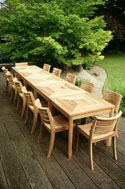About Teak Wood Outdoor FurnitureTeak Wood
Teak is the common name for "Tectona Grandis", a large deciduous tree of the family Verbenaceae, one of the most valuable of timbers. Teak has been widely used in India for more than 2,000 years. The name Teak is from the Malayan word tekka. The tree has a straight, but often buttressed, stem (i.e. thickened at the base), a spreading crown and four-sided branchlets with large quadrangular pith. The leaves are opposite or sometimes whorled in young specimens, about .5 meters (½ feet) long and 23 centimeters (9 Inches) wide. In shape they resemble those of the Tobacco plant, but their substance is hard and the surface rough. The branches terminate in many small white flowers in large, erect, cross-branched panicles. The fruit is a drupe (fleshy, with a stone seed), two-thirds of an inch in diameter. The bark of the stem is about 1.3 cm thick, gray or brownish gray, the sapwood is white; the unseasoned heartwood has a pleasant and aromatic fragrance and a beautiful golden-yellow color, which on seasoning darkens into brown, mottled with darker streaks. The timber retains it's aromatic fragrance to a great age. Native to India, Burma and Thailand, the tree grows as far north as about the 25th parallel in these areas and to the 32nd parallel in the Punjab. The tree is not found near the coast; the most valuable forests are on low hills up to about 3,000 feet. Stands are also found in the Philippines and in Java and elsewhere in the Malay Archipelago. Teak is also planted in Africa and Central America. During the Dry season, the tree is leafless; in hot localities the leaves fall in January, but in moist places the tree remains green until March. At the end of the dry season, when the first monsoon rains fall, the new foliage emerges. Although the tree flowers freely, few seeds are produced because many of the flowers are sterile. The forest fires of the dry season after the seeds have ripened and have partly fallen impede the spread of the tree by self-sown seed. Teak trees on good soil have attained an average height of 18 meters in 15 years, with a girth, breast high, of 0.5 meters. In the natural forests teak timber with a girth of about 2 meters (diameter of about 0.6 meters) is never less than 100 and often more than 200 years old. Mature trees are usually not more than 150 ft high. Due to the oil and rubber found naturally in wood, Teak has a greater ability to withstand the elements than any other wood. For this reason it has been the preferred choice for boats, and in fact it has been used on aircraft carrier decks! This is because of it's ability to resist splintering, warping and rotting. For example, if left un-oiled, Teak furniture will turn a soft dove gray when allowed to remain outdoors. This process will take approximately one year. Teak timber is valued in warm countries principally for it's extraordinary durability. The timber is practically imperishable under cover. Teakwood is well known since early/ancient times as a valuable resource due to it's long life reliability and weather resistance as well as it's workable quantities. Pieces of Teak have been found (in India) over 200 years old and still intact. Teakwood is used for shipbuilding, fine furniture, door and window frames, wharves, bridges, cooling-tower louvers, flooring, paneling, railway cars and Venetian blinds. The decks of the Titanic were covered in Teak and the wood is as good today as the day she sank in 1912. Teak is also used in the Middle East oil industry as one of the very few timbers that can withstand the punishing heat of the desert and will not readily catch fire. Teak can withstand harsh chemicals and is is resistant to fungi, rot and termites. Unlike other woods, Teak does not turn black when in contact with metals. Teak looks best when applied transparent and light colors. It is strong, of medium weight and of average hardness. Teak also refers specifically to the wood and it's characteristic color, which ranges from olive to yellowish gray or moderate brown. Teak furniture dates back to the 19th century used mainly by the Chinese for export to Europe. The Victorian era also incorporated the use of Teakwood during the mechanical era of the 1840's with the invention of presses, veneer cutters, etc., which enabled them to create decorative elegant high class furniture. Nowadays Burma produces most of the world's supply with India, Thailand, Indonesia and Sri Lanka (Ceylon) ranking next in production. Below is a small sample of the wide selection of Teak Furniture that One Way Furniture has to offer. |



 The
Latin name for Teak Wood is "Tectona Grandis Linn". Teakwood or Golden Teak is the
king of hardwoods and is one of the world's most valuable timbers, recognized for
it's durability and stability. Teak is more durable than any other hardwood and
has unparalleled rich beauty. Teak can withstand all types of weather. The Ancient
Burmese and Thai Royalty considered Teak to be a royal tree.
The
Latin name for Teak Wood is "Tectona Grandis Linn". Teakwood or Golden Teak is the
king of hardwoods and is one of the world's most valuable timbers, recognized for
it's durability and stability. Teak is more durable than any other hardwood and
has unparalleled rich beauty. Teak can withstand all types of weather. The Ancient
Burmese and Thai Royalty considered Teak to be a royal tree.